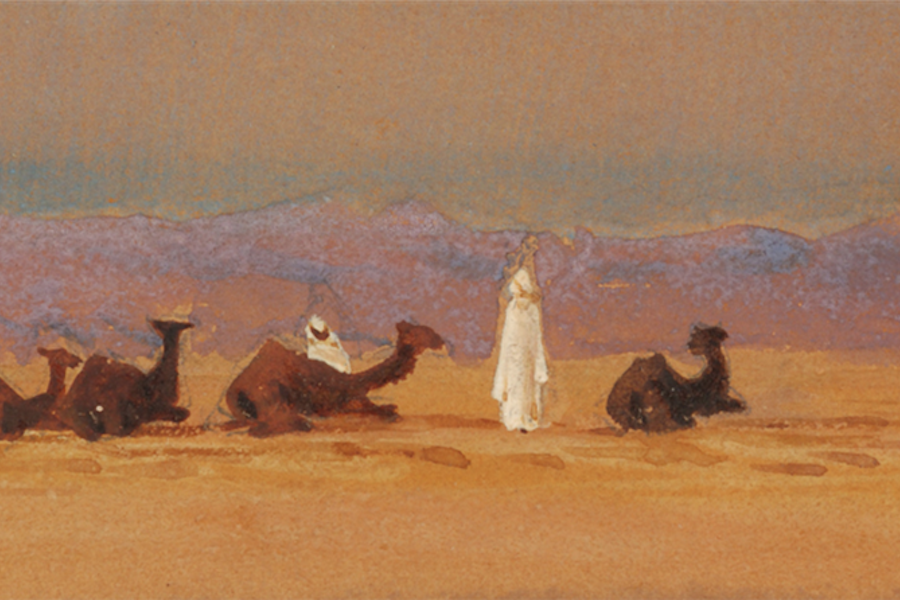What will you do when you stand at a crossroads and must make a choice? What will be the basis of your decision?
At age twenty-six, Lilias Trotter, an accomplished watercolor artist, was compelled to make a life-altering decision. Just three years earlier, she had come to know the famed art critic John Ruskin, who was Victorian England’s most brilliant and influential arbiter of artistic taste. For more than thirty-three years Ruskin’s views on art carried enormous weight with a public eager to follow his lead. Ruskin held that the chief aim of art is to “teach you to see,” insisting “the greatest thing a human soul ever does in this world is to see something and tell what it saw in a plain way. Hundreds of people can talk for one who can think, but thousands can think for one who can see.”1
When Ruskin met Lilias and saw her work, he wondered if the young artist possessed this rarest of gifts. After working closely with her for three years, Ruskin was certain. “He put before Lilias the brilliant future that undoubtedly would be hers if she were to give herself fully to the development of her art.… ‘You would be the greatest living painter and do things that would be immortal!’”2
When Ruskin laid at her feet the commitment of his extraordinary resources for the development of her talent and the promotion of her career, Lilias was elated. The opportunity to develop her talent with a mentor so exceptionally qualified was enticing; the prospect of serving her gift was compelling. And yet, Lilias hesitated. She understood as clearly as did he the condition for the fulfillment of her artistic potential: “to give herself up to art.”
The tension built as Lilias wrestled with her choice. She did not wish to choose, yet she knew she must. And so it was that in May of 1879, Lilias made her decision. “I see as clear as daylight now,” she told a friend, “I cannot give myself to painting in the sense Ruskin means and continue to ‘seek first the Kingdom of God and His Righteousness.’”
What was she thinking, sacrificing her remarkable God-given talent in this way? Biographer Miriam Huffman Rockness observes that onlookers back then and onlookers today may well question the necessity of needing to make such a choice. Could not she have pursued the development of her artistic potential alongside a ministry of service to others? A strong case could be made — one that Lilias doubtless considered — that a life devoted to art might well extend her range of influence and usefulness for the Kingdom of God.
But Lilias, wise soul that she was, understood that what would be required of her in either venture would be complete. The rudder of her soul had already been set toward God’s purposes. Lilias made a decision about what role art would play in her life. It was a decision that penetrated to the issue of obedience, following God regardless of the cost.
My friend Brian Majerus recently observed that every choice involves an offering; we lay down one thing in order to fully take up another. Lilias took her art and placed it at the feet of Jesus. How God would use her life and her art, she determined, would be God’s decision alone. “The one thing is to keep obedient in spirit, to do otherwise would be to cramp and ruin your soul.” In her decision, Lilias experienced “the liberty of those who have nothing to lose, because they have nothing to keep.”3
It took five additional years to put everything into place. In May of 1893, Lilias and two friends finally sailed to Algeria, a Muslim country located in North Africa. The three went without the support of a mission board (Lilias was turned down because of her weak heart). They paid for everything out of their own pockets. They went not knowing a word of Arabic. As single women, they entered a patriarchal society where women had no place or power and where it was illegal for Christian missionaries to plant a church, start a hospital, or build a school.
From the outset, the opposition they faced was intense and opportunities to present the good news of Jesus were severely limited. “A sense of exhaustion comes through the body to the spirit, even apart from the consciousness,” she wrote in her diary. “It is so vivid at times, that the very air is full of the powers of darkness; and the enemy launches his fiery darts in showers on those who come to attack his strongholds. How many of us have gone through the testing of every fiber of our inner life since we left England — and how many of us have known a bitter breaking down under the tests!”3
While most Europeans chose to live apart from the Arab population, the three women secured lodging on a narrow street in the slum area of Algiers. Reaching out to the women living nearby was as difficult as you imagine it would be. Lilias sent a letter back home pleading for prayer support and coverage. To maintain her faith and spiritual balance, she avidly engaged times of daily refreshment alone with God and established a schedule of solitary retreat for herself and for her companions.
As the little team, which had grown to five, befriended their neighbors and provided educational training to their children, Lilias used her art to serve Jesus. She created beautiful evangelistic booklets and pamphlets telling the gospel stories which were then distributed in the marketplaces. Lilias wrote, “The things that are impossible with men are possible with God. May it not be that the human impossibility is just the very thing that sets His Hand free?– & that it is the things which are possible for us to do that He is in a measure to let alone.”4
Over the three decades that Lilias and her team lived and served in Algiers, the work they did showed little outward evidence. It became unspeakably grim for foreign workers as the political situation in Algeria deteriorated. Almost daily they faced the threat to shut down the ministry. In times like these, she wrote, “one literally can do nothing but pray at every available bit… I am beginning to see that it is out of a very low place that one can best believe.” Through it all, the team carried on in dogged persistence, determined to be faithful to God in those things that were possible and trusting God in all that seemed utterly impossible.
The pages of her journal reveal her evolving methodology as Lilias adapted and modified her approach to their mission (modern missiologists report that the strategies she developed over those years were one hundred years ahead of their time!) As one gifted with spiritual “sight,” Lilias was able to see what God was doing and adjust accordingly. She witnessed delightful twists in God’s workings, as God consistently provided just what was needed when and where it was most needed. Alert to God’s ever-changing ways and means, Lilias stayed flexible and prepared for sudden alterations of plan. “Make me love Your will, God, whatever it is!”
In small diaries, Lilias recorded what she observed in the form of insightful reflections, sketches, and tiny paintings. The works of art that John Ruskin had hoped would grace the walls of London homes instead graced her journals, her private tribute to the honor and glory of God. “For all her accomplishments in organization, strategy, and literature, perhaps her most palpable legacy was, in fact, intangible: a ‘wideness and lavishness of love that transformed even trivial gifts till they became akin to a sacrament.’” “‘Lalla Lili’ was like her teaching. To see her was to catch a glimpse of ‘that sweet-smiling Jesus.’”5
Lilias had devoted thirty-five years of her life to loving the people of Albania in Jesus’ name when, toward the close of her seventh decade, her heart finally gave out. Ministry partners and Arab friends surrounded her bed as Jesus drew her to Himself. Lilias was laid to rest in her Algerian home.
So, what became of her pivotal decision to sacrifice a stellar artistic career to follow Jesus to Algeria? There was, in truth, little tangible evidence of success in their work. Was hers a light that flamed brightly for a little while then was extinguished by time and circumstance? Miriam Huffman Rockness speaks of a small, contemporary resurgence of Christian faith in modern-day Algeria that traces back to the ministry of Lilias Trotter and her little team. Still, it is expected that her true legacy will not be revealed until heaven when scores of national believers who accepted Jesus against all human odds then and now will join her in an open and free worship of our Almighty God. What a day that will be!
Image: Watercolor by Lilias Trotter, shared with the permission of Lilias Trotter Legacy.
Text First Published February 2023 · Last Featured on Renovare.org February 2023


